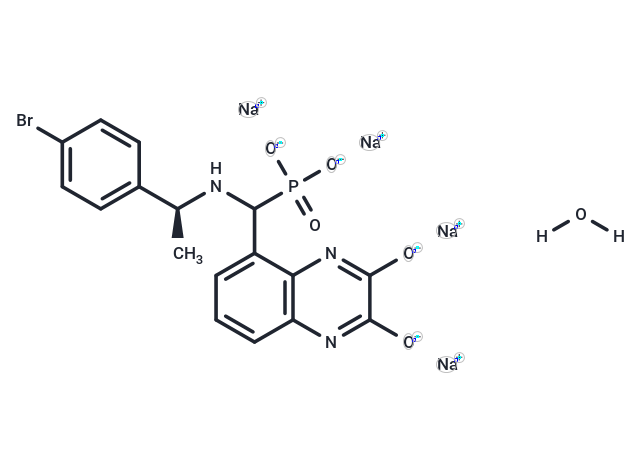Shopping Cart
Remove All Your shopping cart is currently empty
Your shopping cart is currently empty
PEAQX tetrasodium hydrate (PEAQX tetrasodium hydrate (459836-30-7 free base)) is an orally available NMDA antagonist that is potent and selective. The IC50 value of PEAQX tetrasodium hydrate (459836-30-7 free base) against hNMDAR 1A/2A was 270 nM and 29600 nM against hNMDAR 1A/2B, respectively.

| Pack Size | Price | USA Warehouse | Global Warehouse | Quantity |
|---|---|---|---|---|
| 1 mg | $1,070 | - | In Stock |
| Description | PEAQX tetrasodium hydrate (PEAQX tetrasodium hydrate (459836-30-7 free base)) is an orally available NMDA antagonist that is potent and selective. The IC50 value of PEAQX tetrasodium hydrate (459836-30-7 free base) against hNMDAR 1A/2A was 270 nM and 29600 nM against hNMDAR 1A/2B, respectively. |
| Targets&IC50 | NMDAR 1A/2A (human):270 nM, NMDAR 1A/2B (human):29600 nM |
| In vitro | PEAQX has a high binding affinity for NMDA receptors (IC50=8 nM), and a functional preference in excess of 100-fold for hNMDA 1A/2A (IC50=of 270 nM) over 1A/2B receptors (IC50=29,600 nM).[1] |
| In vivo | PEAQX is practically inactive in Xenopus oocytes expressing hNMDA 1A/2B receptors, displays an ED50 value of 23 mg/kg in the MES test [1]. Sprague-Dawley rats were treated on PN7, PN9, and PN11 with PCP (10 mg/kg), PEAQX (NR2A-preferring antagonist; 10, 20, or 40 mg/kg), or ifenprodil (selective NR2B antagonist; 1, 5, or 10 mg/kg) and sacrificed for measurement of caspase-3 activity (an index of apoptosis) or allowed to age and tested for locomotor sensitization to PCP challenge on PN28-PN35. PCP or PEAQX on PN7, PN9, and PN11 markedly elevated caspase-3 activity in the cortex; ifenprodil showed no effect. Striatal apoptosis was evident only after subchronic treatment with a high dose of PEAQX (20 mg/kg). Animals treated with PCP or PEAQX on PN7, PN9, and PN11 showed a sensitized locomotor response to the PCP challenge on PN28-PN35.[2] |
| Synonyms | PEAQX tetrasodium hydrate (459836-30-7 free base), PEAQX tetrasodium hydrate, NVP-AAM077 tetrasodium hydrate |
| Molecular Weight | 560.15 |
| Formula | C17H15BrN3Na4O6P |
| Smiles | [O-]P([O-])(C(C1=CC=CC2=C1N=C(C([O-])=N2)[O-])N[C@H](C3=CC=C(C=C3)Br)C)=O.[H]O[H].[Na+].[Na+].[Na+].[Na+] |
| Relative Density. | no data available |
| Color | White |
| Appearance | Oil |
| Storage | Pure form: -20°C for 3 years | In solvent: -80°C for 1 year | Shipping with blue ice/Shipping at ambient temperature. | |||||||||||||||||||||||||
| Solubility Information | H2O: 22.9 mg/mL (40.88 mM), Sonication and heating are recommended. | |||||||||||||||||||||||||
Solution Preparation Table | ||||||||||||||||||||||||||
H2O
| ||||||||||||||||||||||||||
| Size | Quantity | Unit Price | Amount | Operation |
|---|

Copyright © 2015-2025 TargetMol Chemicals Inc. All Rights Reserved.